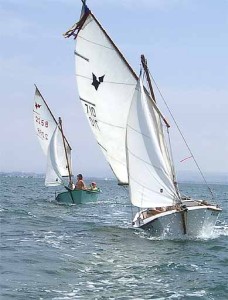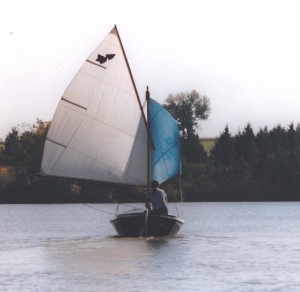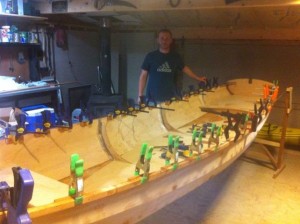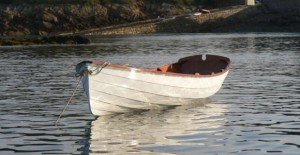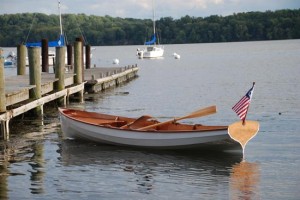Typically it takes a week or so to get one of these Chester Yawl chapters posted. This one’s taken longer than I wanted to show up. My life does not allow time or energy for steady writing but that gives an opportunity to marinate each experience in grey matter. Stirring the rich stew that results requires a search for spice that is challenging to say the least. I could try to say the least about sanding epoxy but you might become as bored as I was with a sanding block in one hand staring down fifteen feet of planking that looked like fossilized cheesecloth.
The latest foray to the boat shed began with a sort of coin-toss choice. Things needing to be done were: sealing the gunwale rails or sanding the skeg and bottom planks followed by some epoxy sealing of the topsides planks. We went for the bottom job for no particular reason other than the job just had to get done. Dave and Bob had laid the fiberglass cloth on the bottom-most planks some time before. This left a bottom that was not entirely flat. There were places with overlaps at the beginning of a new length of cloth. there was a transition where the bottom cloth met the fabric going up the sides of the skeg. These seams needed to be faired in preparation for painting. In typical fashion what was first applied must be altered or hidden for a final effect. After all boatbuilding has a good bit of illusion involved.
The job would be easier if this were a flat bottomed skiff. The job was complicated by the plank laps. They create restricted areas requiring smaller sanding blocks and short strokes. All our sanding was being done by hand. Using an orbital sander, carefully so as not to expose the weave of the cloth, would be faster but the plank widths prevented that. Epoxy is hard stubborn stuff. The most effective tool in dealing with it is simple determination. The ability to grit your teeth and put your mind in low gear for a steady pull is a valuable talent. It helps to have a partner who is sociable and even loquacious.
Between Dave and I we are capable of a steady stream of useless but entertaining conversation. We meandered between reminiscence of past days working together at Westport Shipyards, women, the relative virtues of power vs. sail and sail vs. power, women, oars, Caleb who is now in Kentucky, and how long the current stock of resin would last. Religion, politics and the longevity of string theory as a viable cosmological theory were absent and not missed.
Having spent 30 years living with a fourth grade school teacher I am very familiar with the concept that, “busy hands are happy hands.” The time passed in spite of ourselves and we moved on to sealing the remainder of the planking which is not covered in fiberglass cloth. This is the part where the whole epoxy saturation technique comes by it’s popularity. The method takes mere marine grade plywood and turns it into a tough abrasion resistant material that is as waterproof as you can expect wood fiber to get. We mixed up a preliminary batch of MAS epoxy without adding any thickeners. Rolling it on went well. It’s surprising how far a small amount will go. Okoume plywood is thirsty stuff. Some people like to varnish a hull after this stage. The epoxy is not resistant to ultraviolet rays. Paint does the same job cheaper and with fewer coats. Besides, I have never been partial to the look of bright finished okoume. it just seems to remind my old-school sensibilities that we don’t see much genuine Honduras mahogany these days.
Since this post was written Dave has been busy getting enough done on the boat to do an early launch of the Chester Yawl. That will hopefully be done this weekend. Dave is getting ready to move to California to pursue studies for the ministry at a Bible college. Seems everybody is leaving here lately. First Caleb, now Dave. I’ve enjoyed their companionship and good humor. It has elevated this project to something greater than simply following instructions in a neatly assembled kit. When people come together to build objects they also build community. The bonds we forge display the true value of our skills.


